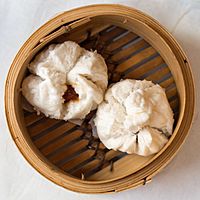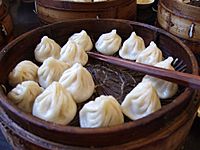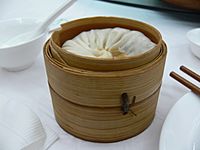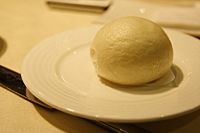Baozi facts for kids
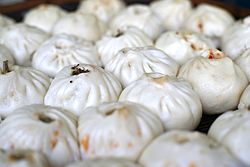
Meat-filled baozi for sale in a market
|
|
| Alternative names | Bao, humbow, pau |
|---|---|
| Type | Filled steamed bread |
| Place of origin | North China |
| Region or state | China, Hong Kong, Taiwan, East Asia, Chinatown in the world |
| Variations | Dabao, xiaobao |
| Baozi | |||||||||||||
|---|---|---|---|---|---|---|---|---|---|---|---|---|---|

"Baozi" in Chinese characters
|
|||||||||||||
| Chinese | 包子 | ||||||||||||
|
|||||||||||||
| Alternative Chinese name | |||||||||||||
| Chinese | 包 | ||||||||||||
|
|||||||||||||
Baozi (Chinese: [] Error: {{Lang}}: no text (help)), often just called bao, is a yummy type of bun from China. These buns are usually filled with tasty ingredients and then steamed. Think of them like a soft, fluffy bread pocket!
Baozi are a bit like mantou, which are plain steamed buns from Northern China. You can find many kinds of baozi, with different fillings like meat or vegetables.
In China and Indonesia, you'll mostly find two main sizes:
- Dabao (大包), meaning "big bun," are about 10 centimeters (4 inches) wide. People usually buy these one at a time to take away.
- Xiaobao (小包), meaning "small bun," are about 5 centimeters (2 inches) wide. These are often eaten in restaurants, where you might get a steamer basket with three to ten of them.
When you eat baozi, you might get a small dish for dipping sauces. These can include vinegar or soy sauce, plus spicy chili pastes or fragrant sesame oil. Baozi are super popular all over China and have spread to many other countries thanks to Chinese people moving around the world.
History of Baozi
Records from the Song Dynasty (which was a long time ago, from 960 to 1279 AD) show that the word "baozi" was already being used for filled buns. Before that, the word mantou was used for both filled and plain buns.
There's a cool legend about how filled baozi came to be! It's said that a smart military leader named Zhuge Liang invented them. Over time, in most parts of China, mantou came to mean only plain buns, while baozi meant the filled ones.
Different Kinds of Baozi
There are so many delicious types of baozi! Here are some popular ones:
| English Name | Chinese Name | What it is |
|---|---|---|
| Cha siu bao | 叉燒包 | These are filled with sweet and savory barbecue pork. They are very popular in Cantonese cuisine from places like Hong Kong. |
| Goubuli | 狗不理 | A special type of baozi from Tianjin, Northern China. It's so famous that there's a restaurant chain named after it! Its name means "Dog ignores it," which is funny because people love them. |
| Xiaolongbao | 小籠包 | These are small, meat-filled baozi from Shanghai. They are famous for having a juicy broth (soup) inside! You have to be careful when you eat them so the soup doesn't spill. |
| Shuijianbao | 水煎包 | Very similar to xiaolongbao, but instead of just steaming, they are also pan-fried on the bottom to make it crispy. |
| Shengjian mantou | 生煎饅頭 | Another small, meat-filled baozi from Shanghai, but this one is fried, making the bottom crispy and golden. |
| Tangbaozi | 湯包 | A large, soup-filled baozi from Yangzhou. Sometimes, people even drink the soup inside with a straw! |
| Doushabao | 豆沙包 | A sweet baozi filled with sweet bean paste. |
| Lotus seed bun | 蓮蓉包 | Filled with a sweet paste made from lotus seed paste. |
| Kaya-baozi | 咖央包子 | These are filled with Kaya, a sweet jam made from coconut and eggs. It's popular in countries like Indonesia and Malaysia. |
| Naihuangbao | 奶黃包 | Filled with a sweet yellow custard cream. |
| Shāobāo, siopao | 燒包 | These are steamed and can be filled with chicken, pork, shrimp, or even salted egg. They are popular in the Philippines. |
| Zhimabao | 芝麻包 | A steamed bun filled with a sweet black sesame paste. |
| Yacaibao | 芽菜包 | Filled with a type of pickled vegetable, spices, and sometimes meat. It's common in Sichuan, China. |
| Bah-pau | 肉包 | This baozi is filled with minced pork. In places like Indonesia, you can also find them with chocolate, cheese, or mung bean fillings. |
| Big Pau | 大包 | These are large buns filled with pork, eggs, and other ingredients. |
| Gua bao | 割包 | This one is different! It's a flat, steamed bun that's folded in half, like a taco. You can fill it with all sorts of yummy things, and it's easy to hold. It started as street food in Fujian, China. |
| Crisp Stuffed Bun | 破酥包 | This bun has layers of lard (a type of fat) in the dough, making it flaky. It can be filled with pork, bamboo shoot, and soy sauce, or with sweet fillings like ham and sugar. |
| Tandoori Baozi | 烤包子 | This is a Uyghur specialty. Instead of being steamed, it's cooked in a special clay oven called a tandoor. It's usually filled with lamb, potatoes, and spices. |
Baozi Around the World
Baozi are a very popular food in many places where Chinese people live. You can eat them for any meal, but they are often a favorite for breakfast. They also make a great snack or a quick meal to take with you.
Because Chinese people have moved to many different countries over a long time, baozi have become popular in other parts of north Asia, Southeast Asia, and even outside of Asia.
- In Buryatia and Mongolia, similar buns filled with beef or lamb are called buuz.
- In Malaysia, the local version is called pau. Malay people have made it their own by filling it with potato curry, chicken curry, or beef curry, similar to their curry puffs. Since many people in Malaysia are Muslims, these buns are halal, meaning they don't contain pork. You can find them sold by the roadside or at night markets.
- In Indonesia, the dish is called bakpau. Besides meat, you can find local fillings like chocolate, sweet potato, or red bean paste. Bakpau is often sold by street vendors. To fit the dietary rules of Indonesia's Muslim majority, the pork filling is often changed to minced beef, diced chicken, or sweet mung bean paste.
- In the Netherlands, you can easily find frozen bapao or bakpao in supermarkets. They are usually filled with chicken and are a quick snack you can heat in a microwave.
- In the Philippines, their version of baozi is called siopao. It was brought by Chinese immigrants a long time ago. Filipino siopao can have fillings like barbecued pork, meatballs, or even chocolate and cheese.
- Thailand has a similar bun called salapao (ซาลาเปา).
- In Japan, baozi are known as chūkaman (中華まん), meaning "Chinese steamed bun." Nikuman (肉まん) is the Japanese name for meat-filled baozi. These are often sold as street food and are kept warm in convenience stores during the colder months.
- In Korea, it's called hoppang. It's a warm snack often filled with sweet red bean paste, but also with vegetables, meat, or even pizza toppings.
- In Cambodia, baozi are called num bao and are a popular snack.
- Bánh bao is the Vietnamese version of the Cantonese tai bao, brought by Chinese immigrants.
- The Myanmar version is called pauk-si (ပေါက်စီ) and is a popular snack in traditional tea shops.
- In Mauritius, baozi are called "pao" (or "pow," "paw"). They are popular among families of Chinese origin. They can be savory, filled with things like Chinese sausage or cha siu pork, or sweet, with sweet pastes.
See also
 In Spanish: Baozi para niños
In Spanish: Baozi para niños


